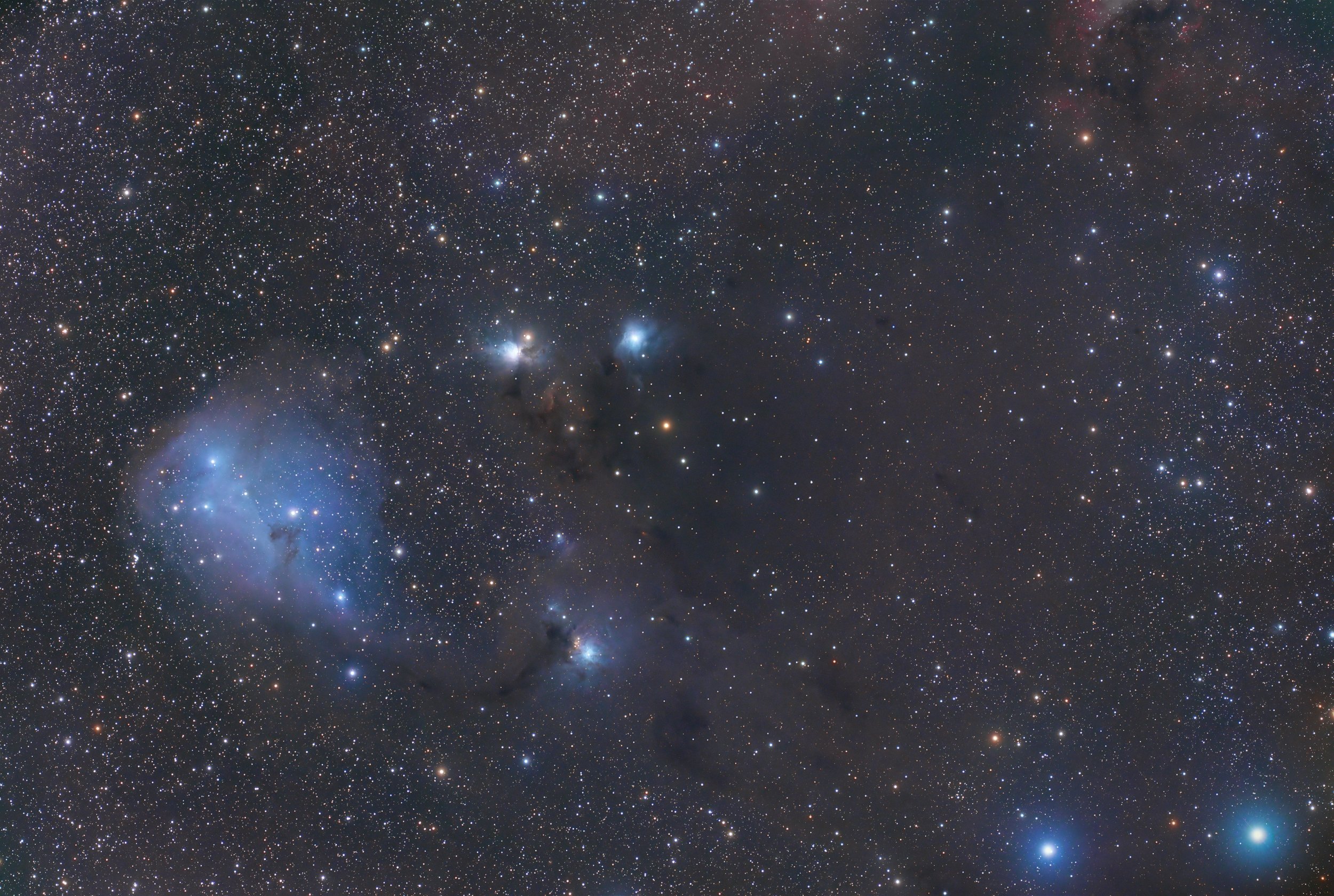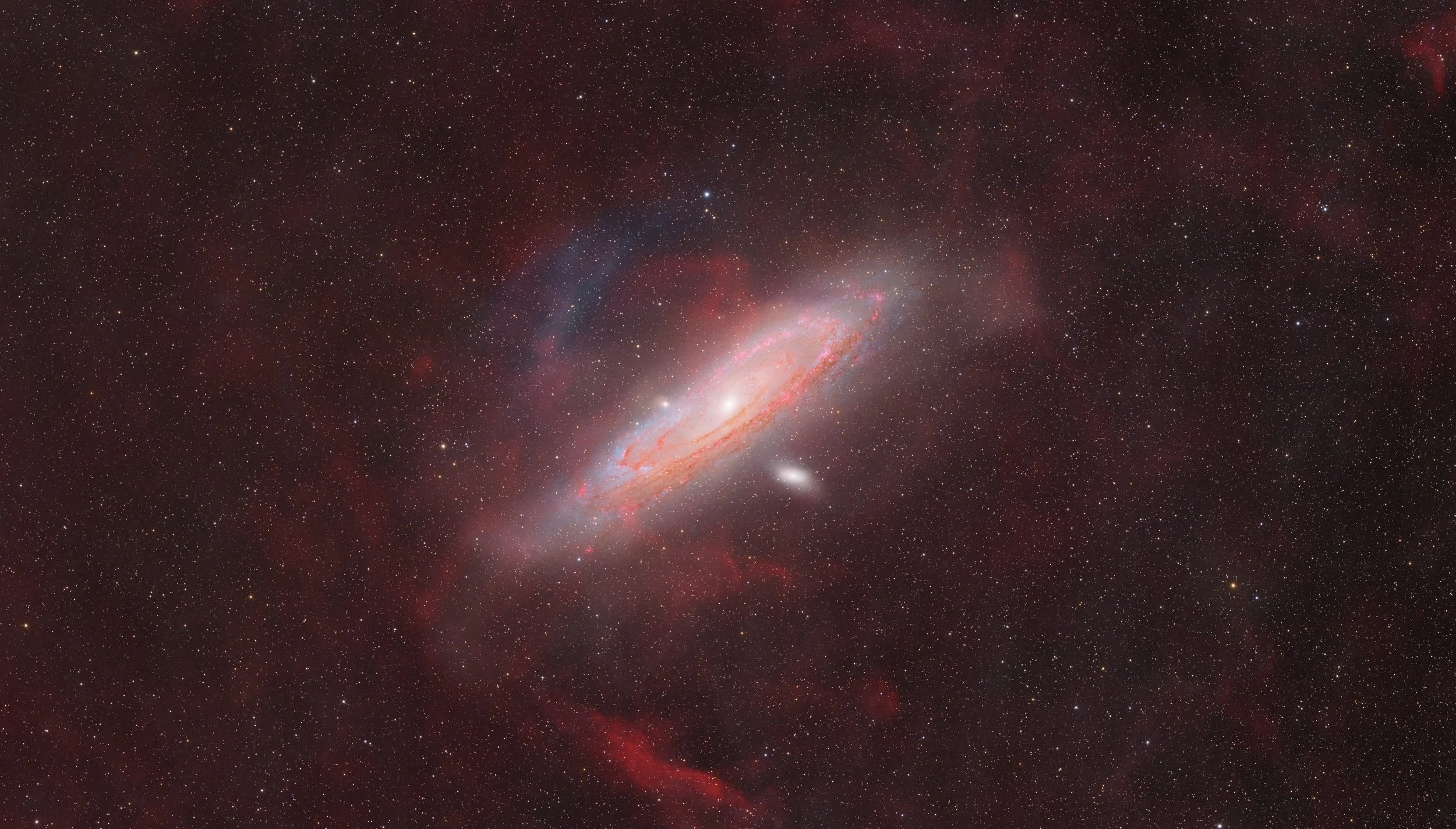
AAPOD2 Image Archives
Sh2-171 / NGC 7822 – A Stellar Nursery in Cepheus
Sh2-171, part of the larger NGC 7822 complex, is a bright emission nebula located in the constellation Cepheus, approximately 3,000 light-years away. This active star-forming region is home to massive, young stars that carve the surrounding gas into intricate shapes through intense ultraviolet radiation and stellar winds. At the heart of NGC 7822 lies the star cluster Berkeley 59, containing some of the hottest known stars in our galaxy, including O-type stars that emit powerful radiation, shaping the surrounding nebula.
This deep image captures the complex interplay of ionized hydrogen (Hα) and sculpted dust pillars, remnants of ongoing star formation. The nebula’s intricate filaments and dark globules represent dense regions where new stars are still forming. Sh2-171 provides an excellent laboratory for studying the effects of massive stars on their environments, as their radiation and winds disperse surrounding material, influencing the next generation of stellar birth.
Angel Nebula NGC 2170
NGC 2170, also known as the Angel Nebula, is a striking reflection nebula located in the star-forming region of Monoceros, approximately 2,700 light-years away. Unlike emission nebulae that glow due to ionized gas, reflection nebulae like NGC 2170 shine by scattering and reflecting the light of nearby hot, young stars. The nebula’s blue hues are the result of shorter-wavelength light scattering more effectively in the surrounding dust, similar to Earth's sky.
This RGB image showcases the nebula’s delicate structures, including interwoven dark filaments of cosmic dust and the warm glow of ionized hydrogen regions. NGC 2170 is part of the larger Monoceros R2 molecular cloud complex, an active stellar nursery where intense radiation and stellar winds shape the surrounding material. The intricate interplay of light and shadow in this region provides a glimpse into the early stages of star formation and the dynamic processes sculpting our galaxy.
Thor's Lightning (SNR G150.3+4.5), MarSai 1, Sh2-204, 207, 208, and 210 (Three-Panel Mosaic)
This expansive three-panel mosaic captures a rarely imaged region in the constellation Camelopardalis, featuring the supernova remnant G150.3+4.5—also known as “Thor’s Lightning”—alongside the faint emission nebulae MarSai 1 and Sharpless 204, 207, 208, and 210. Supernova remnant G150.3+4.5 is an ancient, diffuse structure, believed to be the remnants of a stellar explosion that occurred tens of thousands of years ago. Its faint filaments and ionized gas are difficult to detect, requiring long integration times and specialized narrowband filters to reveal its expanding shock fronts.
MarSai 1, a relatively newly cataloged nebula, adds to the complexity of the scene, while the Sharpless objects contribute a rich interplay of ionized hydrogen (Hα) emissions, sculpted by stellar winds and radiation from young, massive stars. Captured from the dark skies of Deep Sky West, this deep exposure highlights the intricate structure and faint details of these rarely studied objects, providing valuable insight into the late-stage evolution of massive stars and the impact of supernovae on the interstellar medium.
The Rosette
The Rosette Nebula (NGC 2237) is a vast emission nebula located approximately 5,200 light-years away in the constellation Monoceros. This stellar nursery spans over 130 light-years and is home to the young, energetic open cluster NGC 2244, whose intense radiation carves out the nebula’s intricate structure.
Captured from a Bortle 4 site in Myślenice, Poland, this image was processed in the Hubble Palette (SHO), where ionized sulfur (SII) appears red, hydrogen-alpha (Hα) green, and ionized oxygen (OIII) blue. This mapping enhances the nebula’s complex filaments and shock fronts sculpted by stellar winds and radiation pressure. The image reveals the nebula’s inner cavities, formed by the relentless forces of young, massive stars, offering a glimpse into the dynamic processes driving star formation in this iconic deep-sky region.
WR 8 - Rarely imaged Wolf Rayet star in HOO with RGB stars
WR 8 is a rarely imaged Wolf-Rayet star located in the southern constellation of Puppis. Wolf-Rayet stars are massive, evolved stars that undergo intense stellar winds, shedding their outer layers and enriching the surrounding interstellar medium with heavy elements. WR 8 belongs to this rare class, characterized by high surface temperatures and strong emission lines, particularly in ionized hydrogen (Hα) and oxygen (OIII).
Captured from the dark skies of Observatorio El Sauce, Chile, this image combines narrowband HOO data with RGB stars to preserve the natural colors of the field. The nebula surrounding WR 8 is shaped by powerful stellar winds interacting with previous ejecta, creating a complex structure of ionized gas. These turbulent regions are key to understanding the life cycles of massive stars and their impact on galactic evolution. The detailed exposure reveals intricate filaments and expanding shells, emphasizing the dynamic processes occurring in this rarely studied system.
The Seagull Nebula (IC 2177)
The Seagull Nebula (IC 2177) is an emission nebula located on the border of the Canis Major and Unicorn constellations. It is located about 3,800 light years from Earth. The nebula takes its name from its shape which evokes a seagull in flight, with well-extended "wings" and a "head" marked by a particularly bright region. It covers a vast region of the sky with an apparent size of about 120 arc minutes, four times the diameter of the full Moon. This nebula is mainly composed of clouds of ionized hydrogen, illuminated by young stars which emit strong ultraviolet light. The "head" of the Seagull is dominated by a bright star named HD 53367, a massive star of spectral type O. This nebula is a spectacular subject in imaging, for this I used filters duo band Hα/OIII and SII/Hb, which reveal details of the gas structures.
Abell 34
Abell 34 is a large, faint planetary nebula located in the constellation Hydra. It exhibits a distinct, nearly spherical structure with a characteristic bluish-green hue due to ionized oxygen (OIII) emissions. This evolved nebula represents the final stages of a dying star shedding its outer layers, leaving behind a hot white dwarf at its core.
Captured from Fregenal de la Sierra, Spain, this deep-sky image required long integration times to reveal the nebula’s delicate structure against the background sky. Its low surface brightness makes it a challenging target, requiring precise calibration and processing to enhance its faint details while preserving the surrounding field of stars.
104 hours on Andromeda at 135mm
The Andromeda Galaxy (M31), located approximately 2.5 million light-years from Earth, is the closest spiral galaxy to the Milky Way and one of the most iconic objects in the night sky. This image of Andromeda is the result of an extensive data collection process, utilizing over 100 hours of exposure time across multiple locations. The image showcases not only the galaxy’s core, but also the faint hydrogen-alpha (Ha) clouds and ionized oxygen (OIII) arc that encircle it.
Captured from two distinct locations, the first set of data was gathered from Texas, USA, at a remote observatory with dark, clear skies ideal for deep-sky imaging. The second set of data was captured from Calgary, Alberta, Canada, where urban light pollution posed additional challenges. Despite this, the combination of both data sets enabled a comprehensive view of the galaxy and its surrounding nebulosity.









